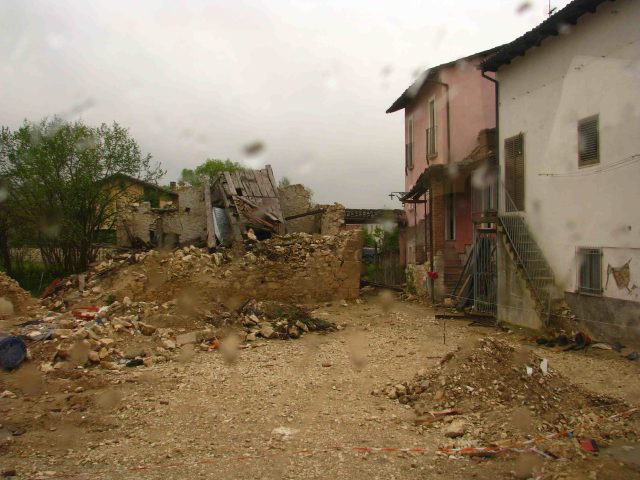
Leandro Pereira
Shared posts
The Hexapod Hexacopter
Leandro PereiraSó faltou o lança-chamas.
Over at Mad Lab Industries, they had the idea of building a quadcopter that could walk and fly. By combining a hexapod with a hexacopter, they ended up with this creation.
The hexapod part started off with PhantomX Hexapod Kit, but it was far too heavy to fly. To reduce weight, they manufactured carbon fibre parts for the frame and legs. Even with the weight reductions, they still needed to six rotors to keep it stable.
The hexacopter part of the build uses more custom carbon fibre parts to mount the motors. The booms and mounts are also custom built out of aluminium. They used six E-Flite motors, propellers, and ESCs to provide lift.
A variety of controllers are used to run the robot. Two Arbotix devices handle the hexapod control, and a Hoverfly flight controller keeps it in the air. It’s controlled remotely using a Spektrum controller.
They have some ambitious next steps, including a mechanism that disconnects and reconnects the hexacopter and the base. After the break, check out a video of this impressive build in action.
Filed under: robots hacks
Most Powerful Magnet in the World
This magnet (seen at 3:15) is crazy. A smaller version is demonstrated at 6:30, they are dropping an aluminum tube through the magnetic field demonstrating Lenz’s Law, we saw Lenz’s Law in action here but the results are a bit more impressive with a super huge magnet!
Command Post 906
Leandro PereiraRad +4 constante.
 Another military object that was used in the Soviet times and absolutely forgotten and abandoned by people today. Time is merciless and it is slowly changing the spaces of this place. This is a battery room: “No entry”. More years … Read more...
Another military object that was used in the Soviet times and absolutely forgotten and abandoned by people today. Time is merciless and it is slowly changing the spaces of this place. This is a battery room: “No entry”. More years … Read more...
Pythagorean Theorem Water Demo
How iOS emulation is reviving an arcane, arcade-inspired retro console
 The original Vectrex (left) and the iOs recreation, seen with an iCade
The original Vectrex (left) and the iOs recreation, seen with an iCade
Anybody who played on classic cabinets like Asteroids or Lunar Lander in the arcades knows that those games' unique, glowing-line graphics were impossible to replicate on standard TV video game consoles. That's because those and many other arcade games used vector monitors, which use a fast-moving electron beam to draw images made up of sharp, straight white lines on a phosphorescent screen. While these vector monitors have trouble with things like color and solid, filled objects, they can create easy-to-rotate figures that were much sharper and cleaner than the low-resolution raster graphics of the time.
In 1982, a company called General Consumer Electric brought the vector graphics experience to the home for the first and only time with the Vectrex, a short-lived, semi-portable game console that was actually came with a small vector monitor of its own. Now, 30 years later, Rantmedia Games is trying to bring the vector experience home again with Vectrex Regeneration, a remarkably authentic iPad emulator for the largely forgotten system.
Regeneration is a bit of a labor of love for Anton Faulconbridge, who was inspired to pursue the project after seeing an iCade and noting its passing resemblance to the Vectrex he enjoyed so much in his youth. "It's the kind of app that I knew that I wanted and I knew that I would buy in an absolute heartbeat if someone else had done it," Faulconbridge told Ars Technica. But it's more than just nostalgia. "I think if you had a reasonable childhood, you kind of look back and think it was amazing, but that's not the reason here. The games are actually good and I think they actually translate well."
Pong Reborn – Rebuilding the original Atari arcade PCB
When Atari released the Pong arcade machine in 1972, it marked the beginning of a new era of video games. This original machine was powered by 66 logic chips on a custom PCB, Reddit user BluesImage has remade this original PCB based on original schematics that were restored and translated by an Atariage forum mamber by the name of Dan Boris.
A real nice professional looking end result which will let you re-create the original for a fraction of the price of a real board.
DSLR trick lets you change focus after taking the picture

Here’s two photographic takes on the same subject, each with a different depth of focus. [Chaos Collective] came up with a way to make interactive still images that allow a user to adjust the depth of focus by clicking on different objects in the image.
This was inspired by the Lytro camera which uses an array of lenses to take multiple pictures at once. Each of those images has a slightly different depth of focus. The technique used here doesn’t require that you buy one of those $400+ cameras. But it’s not a cheap hack unless you already own a camera that can shoot video and has manual focus.
The technique used by the [Chaos Collective] is to move the camera’s manual focus setting from the nearest to the furthest target while capturing a video. That file can then be processed using their browser-based tool which turns it into an embedded HTML5 image.
Filed under: digital cameras hacks
Adventures in mold making and making your own enclosures

The folks at SC-3000 survivors have been working on a cartridge capable of storing dozens of games for the ancient Sega SC-3000 computer. The PCB works beautifully, but making a case for their cartridge left them with few options. They could use a 3D printer or simply collect a whole bunch of used cartridge cases, but making their own mold for a cartridge case was the best solution.
To create the mold for their multicart enclosure, the SC-3000 survivors first took an old, used case and made a silicone mold. While the first attempt at mold making was encouraging, several problems began to crop up due to the lack of vent holes and wiggling the mold before the resin had set. Before long, a proper technique to make resin casts was developed: use lots of resin, and don’t apply pressure or rubber bands to a curing mold.
We’re always impressed by what can be done with a few sheets of plastic, some Bondo, and the inordinate amounts of patience and sandpaper we see with other case mods and enclosure builds. the SC-3000 survivors put together an enclosure that rivals any Bondo build, and we’re happy they put out this tutorial.
Filed under: tool hacks
Breadboard friendly FPGAs

Regular Hackaday readers will be familiar with all the cool things you can do with FPGAs; emulating old video game consoles, cracking encryption protocols, and DIY logic analyzers become relatively simple projects with even a modest FPGA dev board on your workbench. Many FPGA boards aren’t geared towards prototyping, though, and breadboard friendly devices are hard to come by. Here’s a pair of breadboardable FPGAs we’ve found while searching for some related hardware over the past few days
First up is the Mercury FPGA Module. Packaged in a DIP-64 format, the Mercury features a Spartan-3A FPGA with the equivalent of 200k logic gates. Elsewhere on the board is 512kB of RAM and 128kB of Flash storage. There are enough GPIO pins for nearly any project, but sadly only a 10-bit ADC – the same resolution you’d find in an AVR or PIC ‘micro.
Of course the Mercury isn’t the only breadboard-friendly FPGA dev board out there. There’s also the slightly more capable XuLA2 board powered by a Spartan-6 with 32 MB of RAM, 1MB of Flash. Unlike the Mercury, the XuLA2 can also fit in one of those ‘half-sized’ solderless breadboards.
Yes, it’s a different form factor than the commonly recommended Papilio One or the DE0. If you can suggest any other ‘beginners’ (i.e. doesn’t cost an arm and a leg) FPGA boards, leave a note in the comments and we’ll summarize them in another post.
Filed under: hardware
Converting a Chinese laser cutter to work with Mach3

Like most of us, [Chris] has pined over the very, very inexpensive Chinese laser cutters available on eBay for a while now. When most of us disregarded these machines due to their inability to work with the file formats commonly used with laser cutters, [Chris] took the plunge. He was a might disappointed the included software didn’t allow him to use his machine with Mach3 CNC software, so he replaced the included electronics board with one of his own design, giving him all the features of a more expensive laser cutter at a low, low Chinese eBay auction price.
The laser cutter [Chris] bought came with the moshidraw software and controller board that according to one auction can only use BMP, JPEG, WMF, EMF, and PLT files.Wanting a board that can use more common file formats such as PDF and DWG, [Chris] built his own board to communicate with his Mach3 software.
From what we can tell, the new board works with off-the-shelf Pololu stepper drivers and is a complete drop in replacement for the moshidraw board. He’s still finalizing the design, but when the layout, BOM, and schematic are finalized, [Chris] will be putting the files up for everyone to copy. Wonderful piece of work, [Chris].
Filed under: laser hacks, tool hacks
Sword-Dance - Taichi Saotome
Submitted by: SeniorBrinco (via Youtube)
Tagged: mindwarp , gifs , swords , shadows , magic Share on FacebookSimulating CRT or Vector displays for more realistic emulation
 Scaled down it’s not as obvious that this image isn’t a crystal clear rendering of Mortal Kombat gameplay. But we’ve linked it to the full size version (just click on the image) so that you can get a better look. Notice the scan lines? This is the result of an effort to more accurately mimic the original hardware displays used in classic games. [Jason Scott] takes a look at the initiative by describing what he thinks is missing with the picture perfect quality of modern emulators.
Scaled down it’s not as obvious that this image isn’t a crystal clear rendering of Mortal Kombat gameplay. But we’ve linked it to the full size version (just click on the image) so that you can get a better look. Notice the scan lines? This is the result of an effort to more accurately mimic the original hardware displays used in classic games. [Jason Scott] takes a look at the initiative by describing what he thinks is missing with the picture perfect quality of modern emulators.
One such effort is being mounted for MAME (Multiple Arcade Machine Emulator). There is a series of filters available — each with their own collection of settings — that will make your modern LCD display look like it’s a run-of-the-mill CRT. This is a novelty if you’re a casual gamer who dusts off the coin-op favorites twice a year. But if you’re building a standalone game cabinet this may be a suitable alternative to sourcing a working display that’s already decades old.
Filed under: video hacks
Homemade tank joins the battle in Syria

What does a hacker do when going into battle for the freedom of their country? He builds a tank from scratch, of course. It’s a little bit of a stretch calling it a tank as it lacks treads. But it’s got a high-caliber gun mounted on top and has been heavily armored.
There is room enough inside for two people. What may look low tech in this picture is a different story from the cockpit. A pair of LCD monitors display images from five different cameras. You can see the shrouds that protect three of them on the front of the vehicle with a fourth acting as the rear view. A fifth camera mounted on the gun gives the passenger a look at where he’s aiming. A PS1 controller can rotate it and we assume has a fire feature as well. Check out the demonstration video embedded after the break.
[via Reddit]
Filed under: transportation hacks, weapons hacks
Action! Drama! Laughter! Heartache! Suspense!
Dave Derpson's work day has it all!
Submitted by: Unknown
The Maker Movement in Latin America: An Interview with Tiburcio de la Carcova
 While the maker movement reaches all over the world, Latin America has yet to host a Maker Faire. But that's going to change this month. Santiago, Chile will hold Latin America's a mini Maker Faire Dec. 15-16. And by the looks of things it going to be anything, but small.
The man behind the event is Tiburcio de la Carcova, an entrepreneur and video game designer. He's got a great story to tell that shows that the making and hacking is part of Latin American culture.
While the maker movement reaches all over the world, Latin America has yet to host a Maker Faire. But that's going to change this month. Santiago, Chile will hold Latin America's a mini Maker Faire Dec. 15-16. And by the looks of things it going to be anything, but small.
The man behind the event is Tiburcio de la Carcova, an entrepreneur and video game designer. He's got a great story to tell that shows that the making and hacking is part of Latin American culture. Italian scientists convicted of manslaughter for earthquake risk report
 Destruction in the aftermath of the L'Aquila quake.
Cornell
Destruction in the aftermath of the L'Aquila quake.
Cornell
A group of six seismologists were convicted of manslaughter by an Italian court today for their role in the preparation of a risk report on seismic activity in L'Aquila, Italy. The report, which was generally regarded as reassuring, was released about a week before an earthquake struck the town, killing over 300 people. Initial reports indicate that the scientists have been sentenced to six years in prison.
The town of L'Aquila sits on a major fault line, and had been struck by several swarms of small magnitude earthquakes. The Italian government had organized a risk-assessment committee, which included seismologists (including the former head of the National Institute of Geophysics) and government officials. In the week before the earthquake struck, the group told the public that the high incidence of smaller earthquakes were not necessarily precursors of a larger quake. They did, however, also mention that earthquakes were unpredictable, and that building codes in the area needed to be adjusted to provide better seismic safety.
Reportedly, one of the Italian government officials took matters a step further, declaring that there was no danger, and suggesting that the smaller earthquakes had relieved stress on the fault.
Portal's physics engine rebuilt in 25KB—on a graphing calculator
A 20-year-old college student has rebuilt Portal, Valve's 2007 space-bending game, from the ground up, on—wait for it—a graphing calculator. In a display that puts the old calculator versions of Mario and Tetris to shame, Alex Marcolina posted to a gaming forum and reddit on Sunday about his re-engineered version of Portal. It took three years to build and cannot, due to resource constraints on TI-83/84 calculators, execute more than 16 kilobytes of code.
When Marcolina set out to rebuild Portal on TI’s graphing calculator platform, he was 17. Now, he’s a 20-year-old game design major at UC-Santa Cruz who programs games mainly for computers, but likes to dabble in graphing calculator games on occasion because it's “a fun challenge to make a game for a platform that is not supposed to even support games."
The native language for the TI-83 and 84 calculators is called TiBasic. But when it comes to making games, creators favor a language called Axe, developed by a member of the calculator and PC gaming forum Omnimaga. Marcolina points out the syntax for Axe is “very loose, but it allows for good optimization in the translation from code to assembly.”
To represent portal travel, Marcolina told Ars he had to create two separate sets of variables: x and y for regular space, and i and j for “Portal Space” (when the player is moving through a portal). i represents how far into the portal the player is, and j the side-to-side movement relative to the portal.







